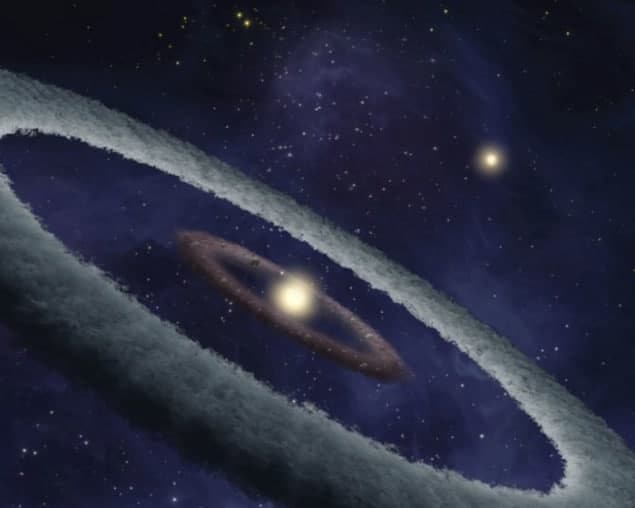
Two US astrophysicists claim they have answered an important question about how planets form: why don’t young planets get pushed into their companion stars before they have a chance to grow? It turns out that a little company is enough to keep them there, say the researchers, who argue that multiple planets moving through a rocky disk can prevent one another from falling into the star.
“All young planets are subject to migration,” says Scott Kenyon of the Smithsonian Astrophysical Observatory in Massachusetts, who did the work with Benjamin Bromley of the University of Utah. “Migration for gas or ice giants is more commonly discussed, but migration is also an issue for terrestrial planets with masses ranging from that of Pluto to the Earth.”
Astronomers believe that planets form in a disk of gas and dust surrounding a young star. The first step towards planet formation is the planetesimal – a small rocky body with radius of roughly 1–10 km. As the dust condenses into planetesimals during the first few million years of a star’s life, larger rocks begin to emerge that grow much more rapidly than the rest. These bodies, termed oligarchs, are on their way to young planethood, using their gravitational pull to attract and pack on more planetesimals.
Pushy planetesimals
In addition to providing a means for growth, planetesimals can also push an oligarch towards its doom in the central star. A lone oligarch orbiting through the disk of planetesimals clears a path much like a stick being dragged through sand. The planetesimals on either side of the trench press on the oligarch, says Kenyon, and as the outer ring has more mass, the planetesimals deliver a net inward push.
In the past, magnetic fields, turbulence and thermodynamics have been used to explain how rocky planets are prevented from falling into their stars. However, Bromley and Kenyon say that the wake patterns created by multiple oligarchs circling a star are enough to prevent structures from forming in the planetesimal disk that would push the young planets in.
Once the oligarchs account for about half of the material in the disk, a few tens of millions of years after the birth of the star, they begin making even more material gains by combining with one another. Rather than hollowing out a series of trenches, the oligarchs are now randomly scrawling in the planetesimal “sand”, which also prevents the planetesimals from settling into patterns that would feed the oligarchs to the star.
Real, but not clear
“This is a real effect,” says John Papaloizou of the University of Cambridge in the UK. “However, its extension to interactions with gas is not clear.”
Making direct calculations of the movements of multiple planets through a more realistic disk of gas and planetesimals raises the complexity significantly, requiring more computing power than is practical today. Instead, Bromley and Kenyon extended their simulation to gas disks.
They looked for scenarios in which a gas cloud behaves like a disk of planetesimals, and they found two key requirements: the gas must have low viscosity; and the planets must be small. A denser, high-viscosity gas has a stronger tendency to smooth itself out after the oligarch runs through – like the wake of a canoe in water. This means that the disruptions to the patterns do not last as long. If the gas in the disk is dilute, the researchers argue that these conditions are met well enough that rocky planets should not fall into the star.
“Our results tell us that growing terrestrial protoplanets cannot migrate through a disk of planetesimals, allowing protoplanets to grow into the planets we see in our and other planetary systems,” says Kenyon. If the generalization to gaseous disks is realistic, then Kenyon believes that “we are a step or two closer to understanding the origins of the Earth and other planets”.
This research appears in the Astrophysical Journal 735 29.



